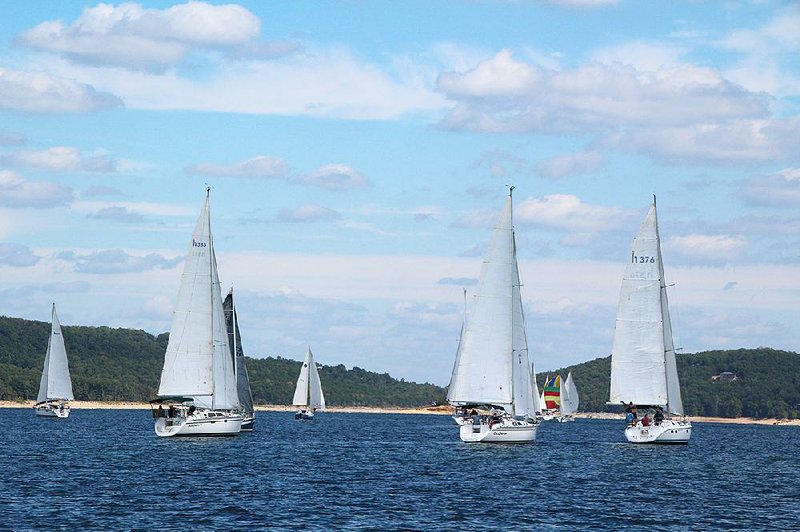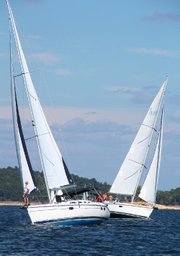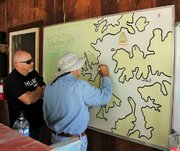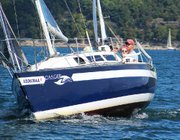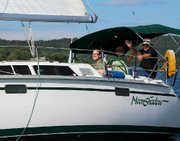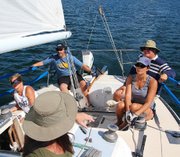"They race sailboats in Arkansas?" was my immediate, unfiltered response when my friend, Eric Bernheisel, asked if I was interested in joining a crew for a sailboat race.
At that time, being a landlubber, I was not even aware there were enough sailboats in Arkansas to have a race.
However, shortly after that conversation, Bernheisel invited me out on his Prindle 16 sailboat for my first sailing adventure. With the catamaran docked at the Beaver Lake Sailing Club, I quickly became aware of the large sailing community harbored within the Natural State.
But to race them on a lake? This was definitely an activity I wanted to experience firsthand.
Luckily I didn't have to wait long. The club's annual King of the Lake sailboat race was scheduled for the last Saturday of September. Bernheisel felt this would be a great introduction to the sport for me.
The origin of the Beaver Lake Sailing Club can be traced to March 1965, when Jim Dunn hoisted what was most likely the first sail on Beaver Lake. Dunn hauled his 15-foot-3-inch Demon sailboat down a graveled track to launch in the rising water within sight of the unfinished dam. His wife, Rae, also an avid sailor, was expecting a baby, so Jim was solo on this maiden voyage.
During the summer of that year, as the lake began to fill and lure more sailboats, the Dunns met other kindred spirits who shared their interest in the sport.
The following winter the pair proposed forming the Beaver Lake Sailing Club, and Jim Dunn was elected its first commodore.
On Labor Day 1966, the club organized the first regatta held on Beaver Lake. Skippering his Flying Dutchman, Ed Buckle was awarded the winning trophy by Republican gubernatorial candidate Winthrop Rockefeller.
Over the years, home base for the club drifted around the lakeshore, from the banks of a member's property to Rocky Branch Marina and, finally, in 1978, to its current location at 11184 Latham's Landing Road in Garfield.
This shoreline lot, located on the banks of a deepwater cove, provided protection from the wind and offered a reasonable slope for anchoring docks. Perfect.
Over the years members of the Beaver Lake Sailing Club have been major players in sailboat racing, within the state and across the country.
Their clubhouse has greatly improved and now includes a kitchen, toilets and showers, an open-sided pavilion, and an elevated boat trailer for members to haul their boats out of the water for maintenance.
The club's 250-plus members have more than 100 sailboats docked at the club's five slips.
KING OF THE LAKE
Beaver Lake Sailing Club now leans more toward social events than racing, but its members are still competitive.
"One sailor on a lake is a cruiser; put another in the same body of water and you have a race," says current Commodore Mike Carron.
The competitive spirit is exemplified by this year's 50th running of the King of the Lake sailboat race. The early morning sign-up board already had listed 17 sailboats scheduled to compete.
When I arrived at the clubhouse on the morning of the big race, skippers were milling about the open-ended pavilion talking equipment and race strategies, using nautical words and terms that I didn't understand.
Dunn, now vice commodore, was busy at a laptop computer, "crunching the [Performance Handicap Racing Fleet] numbers," and preparing starting positions for the roster of competing boats.
That's pretty complicated work, it turns out. The Performance Handicap Racing Fleet is a handicap system for boat racing that allows dissimilar classes of sailboats to compete against one another. Basically, it's a system of applying a time-rating figure to each sailboat.
In the club's pursuit race, these assigned times meant the boats would begin the race at
defined intervals, with the fastest vessels starting last. In theory, by employing this handicap system, all the boats would finish together, making for an exciting finish for participants and spectators.
Armed with projected wind forecasts and his own experience with wind direction and the effects on it by the lake's surrounding hills, he boarded the race committee boat to mark the course using bright orange buoys.
Upon his return, with skippers anxiously peering over his shoulder, Dunn began marking the race course on a white board. Upon completion, he began the skipper's meeting, where he explained that because of the day's slow wind speed, the race would be two laps around a 3.2 mile triangular course, with each turnabout marked by an orange buoy.
Details and skipper questions fully satisfied, Dunn and Bill Anderson welcomed me aboard the race committee boat for a front-row seat to view my first sailboat race.
Dunn is all about tradition when it comes to sailboat racing. He flew the Beaver Lake Sailing Club color flags on the committee boat mast and hauled a miniature cannon to proclaim the official start and finish of the race with a boom.
Dunn utilized a sequence of colored flags on the race committee boat mast and a series of air horn blasts to communicate with the boats.
As a backup form of interaction, everyone carried walkie-talkies.
Each competing sailboat had been assigned a designated time to cross an imaginary start/finish line stretched between the race committee boat and a buoy. They could cross the line later than this time, but an early crossing would result in their having to circle around to pass through once again.
It was exciting to watch the fleet of sailboats in the crowded staging area behind the start/finish line, and with their tall winglike sails they hovered about like circling falcons, preparing to swoop across the start line with as much momentum as possible.
RACE ON
With a boom from Dunn's cannon, which echoed off the surrounding bluffs, the race was officially underway. I was amazed as each of the boats sailed past our bow within seconds of their assigned time. Their sole source of propulsion came from the unpredictable wind. How could they have such control?
From the viewpoint of the race committee boat we could witness the entire race course as the Beaver Lake Sailing Club fleet glided across the lake's pristine waters to reach each buoy. For my benefit, Dunn and Anderson described the various tactics and maneuvers of the competing sailboats.
Considering that each boat was being powered by the same prevailing wind, I was surprised to see some boats jibing to port side while others chose starboard.
On the following day I would better understand, when I would help crew one of the sailboats and actually take a turn at the helm.
While at the helm I realized that the skipper of a sailboat is much like the leader of a large orchestra, with anything moving in his view a member of his ensemble: the leaves of trees on the shoreline, ripples of both nearby and distant waves, the fluttering sails of fellow boats, along with the various ribbons, strings and even narrow strips of an ABBA audiocassette tape attached to the various sections of riggings.
The skipper will keep constant watch to determine which direction to guide the vessel to capture the briefest puff of wind in his sails for an advantage their opponents had not observed.
The chosen route the vessel follows is based on the opinion of the skipper after collecting this data. This explains the variety of tactics being taken by these boats.
At the end of the first lap, Banjo and Dreamer had overcome the almost 14-minute handicaps they had been assigned. We watched intensely as the two sleek vessels hugged the turnabout buoy, which was positioned mere feet off the bow of the race committee boat, then sailed on to the next leg of the race.
As the pair of competitors rounded the distant Starkey Island to begin the long straight stretch to the finish buoy, they were still in a dead heat. Having chosen to follow opposing routes for their final sprint down the home stretch, each ensuing tacking maneuver resulted in their paths crossing.
I was reminded of speed skaters in the winter Olympics, approaching one another as they crossed over to the opposite lane. As with the skaters, neither skipper flinched as they forged onward with what could be a potential collision course at each crossing.
With the course of the two vessels carrying them to opposite sides of the lake it was difficult to determine which boat had the advantage. The suspense continued to build all the way to the final moments of the race when Banjo cruised past the race committee boat just ahead of Dreamer, thus establishing Rob Stivers as the 2016 King of the Lake.
Racing over, there was dinner and entertainment, with the music of local favorite band, Earl and Them, under a star-filled sky as people danced late into the night.
It was another great day to be outdoors in the Natural State.
ActiveStyle on 10/24/2016

